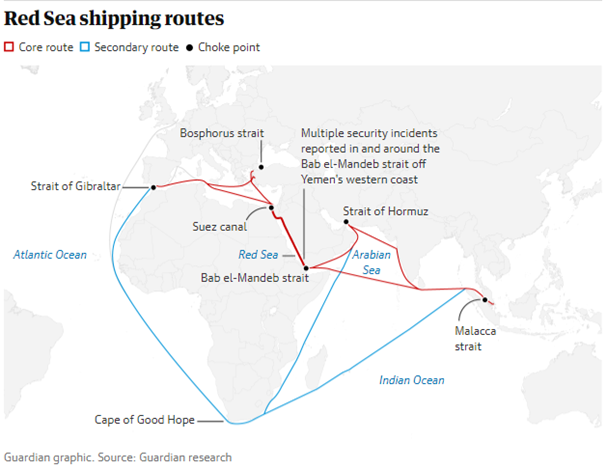3 min read
The Impact of the Suez Canal Disruption on Pulp Prices and Shipments
ResourceWise
:
Jan 23, 2024 12:00:00 AM

By the end of December, major freight companies like MSC, the largest container shipping line globally, made an important decision. They announced their intention to avoid the Suez Canal due to the increasing attacks on commercial vessels in the Red Sea by Houthi militants in Yemen.
These assaults, occurring on a crucial East-West trade route, have prompted a significant change in shipping routes. Instead of taking the shorter route through the Suez Canal, over 100 container ships have rerouted around southern Africa. This diversion adds approximately 6,000 nautical miles to the typical journey from Asia to Europe, resulting in potential delivery delays of three to four weeks.

The Suez Canal, with around 19,000 ships passing through annually, is a vital trade route for goods and fossil fuels moving between Asia and Europe. The disruption caused by these attacks has already led to an increase in oil prices.
Michael Aldwell, Kuehne and Nagel’s board member for sea logistics stated, “The extended time spent on the water is anticipated to absorb 20% of the global fleet capacity, leading to potential delays in the availability of shipping resources. Moreover, delays in returning empty equipment to Asia are likely to pose challenges, further impacting the overall reliability of supply chains.”
What Does This Mean for Pulp Shipments?
Due to the occurrences in the Suez Canal causing ships to take longer routes to reach Asia, exporters will undoubtedly experience notable consequences.
Take, for example, the transportation of pulp from Rotterdam to Asia. This extended journey will result in an estimated additional 10-11 days of travel time. Not only that, but the rising cost of containers, priced at 1,000 eur/40 ft, will also lead to a significant 30% increase in expenses.
Similar effects are likely to be seen in shipments from other prominent European ports as well. And as the Chinese New Year approaches, there will likely be a demand for increased pulp imports into Chinese ports.
However, one of the many questions to be asked is, who will be capable of fulfilling this requirement?
Implications for Global Pulp Prices
When we utilize our databases to test what would happen in the softwood pulp market, we can draw a few conclusions. We can see that if transportation times for pulp shipments increase, this will postpone the next turning point of softwood prices in China, which will lead to higher pulp prices. Increases will first occur in China, with Europe following shortly after. Increased freight costs will, however, erode at least some of the price gain.
Possible Outcomes for Softwood Pulp Prices
 Source: ResourceWise-STE Forecasts
Source: ResourceWise-STE Forecasts
In addition to increased costs, softwood import volume from Europe to China will decrease due to the increased freight rate. This increases not only pulp floor prices in China, but also tightens the softwood supply and demand balance if no compensating imports are found.
This would also slightly fuel and support the transition from softwood pulp use to hardwood pulp use in China. However, it’s important to note that not all softwood pulp can be replaced with hardwood.
The pulp market has gone through a significant destocking trend in China. Other markets can lead to a situation where demand for softwood pulp can spike due to delayed deliveries into China.
This scenario would also see the European softwood pulp supply and demand balance soften and prices decline in the short term. However, as soon as exports from Europe to China return, they will return with a surge due to China’s pulp inventories being low. The consequence will be a tighter supply and demand balance and increasing prices in Europe.
Navigating the Rough Waters Ahead
As Danish physicist and Nobel prize winner Niels Bohr once said, “Prediction is very difficult, especially if it’s about the future.”
We currently live in an incredibly unpredictable and volatile time, and it has become increasingly challenging for businesses to accurately plan for the future and navigate the unexpected twists and turns that lie ahead.
However, there is a solution that can alleviate some of that guessing work and navigate businesses through the uncertainty—investing in high-level market intelligence platforms.
By gaining access to data-driven platforms, you can utilize system dynamic modeling to uncover valuable market opportunities and assess potential risks that arise with each new disruption. With this valuable insight at your fingertips, you can confidently make optimal decisions, guided by a clear understanding of the market landscape.
A great example of this is ResourceWise-STE Forecasts, developed jointly by Fisher International, a legacy ResourceWise company, and STE Analytics, a professional data modeling firm. Powered by good data, industry understanding, and System Dynamics mathematical models, ResourceWise-STE Forecasts simulate the key drivers of markets and how they interact. This includes supply, demand, price, inventories, order rates, shipments, imports, exports, and market leadership.
With this information, these forecasts offer:
- Exceptional capabilities for predicting market behavior
- Impact analyses of companies’ actions on markets
- The ability to optimize strategies for income
Utilizing our market intelligence platforms, ResourceWise can help you answer questions such as:
- What is the impact on pulp inventories in China and other countries in the region?
- How long might these impacts last?
- What strategies could buyers and sellers use to manage the situation?
If you want to learn more about how ResourceWise's range of data platforms can assist you in navigating these challenges and other related issues, contact us today.





